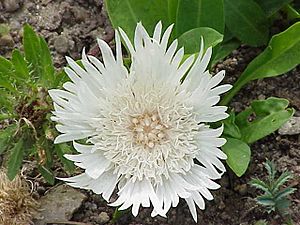Stokes' aster facts for kids
Quick facts for kids Stokes' aster |
|
|---|---|
 |
|
| Conservation status | |
| Scientific classification | |
| Kingdom: | |
| (unranked): | |
| (unranked): | |
| (unranked): | |
| Order: | |
| Family: | |
| Tribe: |
Vernonieae
|
| Genus: |
Stokesia
L'Héritier de Brutelle
|
| Species: |
S. laevis
(Hill) Greene
|
| Binomial name | |
| Stokesia laevis |
|
| Synonyms | |
|
Carthamus laevis |
|
Stokesia is a unique type of flowering plant. It belongs to the daisy family, called Asteraceae. There is only one species in the Stokesia group, and it is named Stokesia laevis. People often call it Stokes' aster or simply stokesia.
This plant grows naturally in the southeastern parts of the United States. It is known for its pretty flowers that bloom in the summer.
What Does Stokes' Aster Look Like?
Stokes' aster flowers are usually purple, blue, or white. They add a lovely splash of color to gardens. Because they are so beautiful, many people grow them in their yards.
There are also different types of Stokes' aster that people have grown. These are called cultivars. For example, 'Klaus Jelitto' has a bright cornflower blue color. 'Colorwheel' starts white and slowly turns purple. 'Blue Danube' has blue flowers with a white center. You can even find more unusual types, like 'Rosea' with pink flowers or 'Mary Gregory' with yellow ones.
A Special Plant Oil
Stokes' aster is interesting because it contains a special oil. This oil is called vernolic acid. It is a type of vegetable oil. This oil can be used for different things in businesses and industries. Some other plants, like certain types of Vernonia, also have this special oil.
Who Was Jonathan Stokes?
The plant genus Stokesia was named after a person. His name was Jonathan Stokes. He lived from 1755 to 1831. Jonathan Stokes was an English botanist and physician. A botanist is a scientist who studies plants.
See also
 In Spanish: Stokesia laevis para niños
In Spanish: Stokesia laevis para niños


